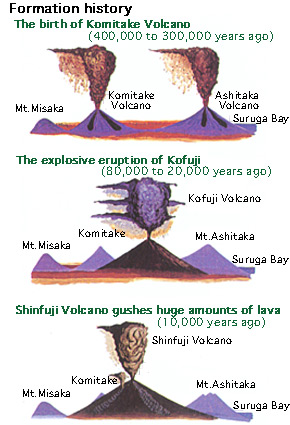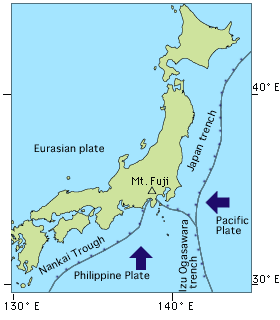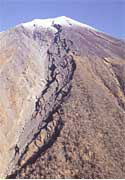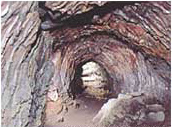|
Mt. Fuji's geography and geologic features : Mt. Fuji's Nature : top
|
|
|
 Mt. Fuji's climate Mt. Fuji's climate
 Mt. Fuji's geography and geological features Mt. Fuji's geography and geological features
 Mysterious groundwater and springss Mysterious groundwater and springss
|
|
Mt. Fuji's geography and geologic features
|
|
Mt. Fuji's composition
Mt. Fuji is one of the few large composite volcanoes made of basalt in the world. Its current beautiful cone shape was caused by eruptions during three periods: Komitake, Kofuji, and Shinfuji.
An explosive Edo Period eruption 1707 created Hoei Crater and formed the huge volcanic ash field on the east side. Mt. Fuji has been dormant since then.

|
Mt. Fuji's location and form
Typical of a composite volcano, Mt. Fuji has a smooth slope and a wide spreading base, creating a beautiful skyline as it narrows to a magnificent peak.
It is said that the main cause of Mt. Fuji's volcanic activity is the Pacific Plate sinking under the bottom of the Philippine Plate, just like the other volcanoes in the Fuji volcanic belt.
Three plates overlap each other near Japan, and Mt. Fuji is located where the Nankai Trough is being bent northwards due to the Izu Peninsula's impact on Honshu.

|
|
Geological Characteristics
Mt. Fuji has a composite structure due to multiple accumulations of lava, lapilli, and ash from repeated eruptions.
It is unique that Mt. Fuji's volcanic product is basalt, given that most other Japanese volcanoes are made of andesite.
|
|
Shinfuji's Volcanic History
| Period |
Activity |
| 11,000 to 8,000 years ago |
Released huge amounts of lava from the peak crater (ancient lava flows) |
| 8,000 to 4,500 years ago |
Ash gushed intermittently from the peak crater (quiescence) |
| 4,500 to 3,000 years ago |
Large-scale lava and small-scale ash gushed from the peak crater and side volcanoes (mid-term lava stream). |
| 3,000 to 2,000 years ago |
Frequent explosive eruptions, mainly from the peak crater |
| 2,000 years ago to recent years |
Repeated gushes of lava (new period stream) and ash from the side volcanoes. Huge eruptions occur approximately once every 500 years. The eruptions recorded in 800 , 864 and 1707 were especially large. |
|
|
Rare geography and geological phenomena
Basalt lava has low viscosity and spreads easily over a broad area, creating a unique landscape of many lava caves and tree molds.
|
Osawa collapse
Mt. Fuji is a relatively young volcano, having gained its present shape approximately 10,000 years ago. However, valleys have been created by corrosion from wind, rain and snow. The largest, Osawa, extends from the right below the west side peak and is said to have been first created approximately 1,000 years ago.
It is thought that a large runoff like the Osawa collapse remains because of few ash falls are present on the west side but ash covers the east side with each eruption.

"Osawa collapse"
|
|
Lava caves and tree molds
|
|
|
|
|



